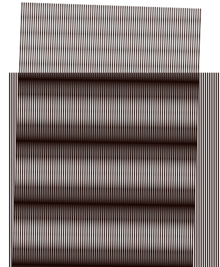|
GratingLook up grating in Wiktionary, the free dictionary. A grating is any regularly spaced collection of essentially identical, parallel, elongated elements. Gratings usually consist of a single set of elongated elements, but can consist of two sets, in which case the second set is usually perpendicular to the first (as illustrated).[1] When the two sets are perpendicular, this is also known as a grid (as in grid paper) or a mesh. As filtersA grating covering a drain (as illustrated) can be a collection of iron bars (the identical, elongated elements) held together (to ensure the bars are parallel and regularly spaced) by a lighter iron frame. Gratings over drains and air vents are used as filters, to block movement of large solids (e.g. people) and to allow movement of liquids. A register is a type of grating used in heating, ventilation, and air conditioning, which transmits air, while stopping solid objects.
As deckingGrating can also come in panels that are often used for decks on bridges, footbridges and catwalks. Grating can be made of materials such as steel, aluminum, fiberglass. Fiberglass grating is also known as FRP grating. They are used to optimize bending stiffness while minimizing weight.
Optical grating  As optical elements, optical gratings are images having the characteristic pattern of alternating, parallel lines. The lines alternate between high and low reflectance (black-white gratings) or high and low transmittance (transparent-opaque gratings). The grating profile is the function of the reflectance or transmittance perpendicular to the lines. This function is generally a square wave, in that every transition between lines is abrupt. A grating can be defined by six parameters:
Gratings with sine wave profiles are used extensively in optics to determine the transfer functions of lenses. A lens will form an image of a sine wave grating that is still sinusoidal, but with some reduction in its contrast depending on the spatial frequency and possibly some change in phase. The branch of mathematics dealing with this part of optics is Fourier analysis while the associated branch of study is Fourier optics. Gratings are also used extensively in research into visual perception. Campbell and Robson promoted using sine-wave gratings by arguing that the human visual performs a Fourier analysis on retinal images.[3] Diffraction gratingsGrating can also refer to a diffraction grating: a reflecting or transparent optical component on which there are many fine, parallel, equally spaced grooves. They disperse light, so are one of the main functional components in many kinds of spectrometers, which decompose a light source into its constituent wavelength components. See alsoReferences
Wikimedia Commons has media related to Gratings. |





